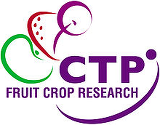RefERENCE: CTP_FCR_2020_11
Supervisors: Dr Charlotte Nellist (NIAB EMR), Dr Helen Cockerton (NIAB EMR), Prof Matthew Dickinson (University of Nottingham), and Dr Tim Robbins (University of Nottingham)
This student will be registered with the University of Nottingham. Beginning in October 2020, the successful candidate should have (or expect to have) an Honours Degree (or equivalent) with a minimum of 2.1, in Plant Science, Plant Biology or Biological Sciences related degree, ideally with an emphasis on plant genetics or plant pathology.
Background
Botrytis cinerea, Grey Mould disease, is a common necrotrophic fungal pathogen of soft fruit crops and causes huge economic losses each year. The pathogen preferentially infects damaged or senescing tissues, such as flowers and fruit, eventually leading to tissue death. Cultivated strawberry (Fragaria x ananassa) accessions appear to be universally susceptible, although variation of incidence and severity to grey mould has been reported. Resistance/tolerance has been reported in the wild progenitors Fragaria chiloensis and Fragaria virginiana. Several known fungal inhibitors are highly induced in resistant F. chiloensis accessions, but the mechanism of resistance is not understood. In raspberry, much less is known, although resistance to cane botrytis has been associated with Gene H, which controls cane pubescence.
NIAB EMR has a collection of wild strawberry material that can be screened for resistance/tolerance to grey mould. It also has wealth of genomic data on the cultivated strawberry and several wild accessions, which can be mined for presence of known components of tolerance to B. cinerea. At present, there are very few genomic resources publicly available for raspberry; this is hampering research on a range of traits including disease resistance.
Objectives and approaches
The project will focus around the following two questions: 1) what are the genetic components of Rosaceae–Botrytis interactions?; and 2) what can usefully be brought from wild species into cultivated strawberry and raspberry to protect against B. cinerea?.
The research will centre on the following research activities:
- Screen diverse strawberry and raspberry material, including wild relatives for tolerance/resistance to Botrytis fruit rot in controlled experiments.
- Characterise the genetic pathways of the cultivated strawberry-B. cinerea and raspberry-B. cinerea interaction through molecular analyses of the infection process and build upon what is known in other systems, e.g. tomato.
- Transform cultivated strawberry and raspberry (using CRISPR) with known pathogenesis-related proteins from wild strawberry and determine effects on Botrytis colonisation.
Training
The successful candidate will gain a wide range of experience in plant pathology, plant breeding and molecular biology, including statistical analyses and bioinformatics. Moreover, this project is relevant to the UK horticulture industry because it will advance our understanding of the molecular basis of Rosaceae–Botrytis interactions and will also lead to improvements in breeding material, reducing losses from this devastating disease, as well as building up resources for strawberry and raspberry.
Application
Anyone interested should return the application and equal opportunities forms to recruitmentctp@emr.ac.uk citing the reference before the deadline of 28th February 2020.
Contact Dr Charlotte Nellist (charlotte.nellist@emr.ac.uk) for an informal discussion.
